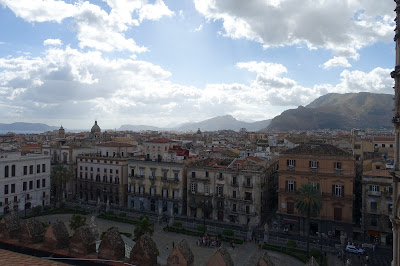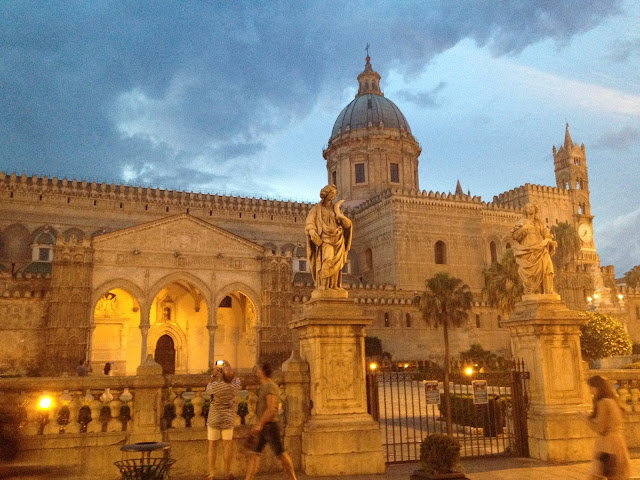In order to understand Sicily a little better, I downloaded
a book on its history and dutifully read up over lunches and dinners while in Palermo. Turns out its history is a lot more turbulent than I knew. Due to its strategic location in the Mediterranean, it seems just about everyone had a go at conquering it (or at least ruling it, conquering often not required due to dynastic entanglements), from Phoenicians to Greeks to Romans to Arabs to Normans to French to Spanish. I got to the 18th century before I left Sicily and abandoned the book, which was disappointingly light on any information about the daily lives of ordinary people, and heavy on a parade of mostly indistinguishable foreign rulers.
However, I did enjoy the earlier parts of the book, including learning about the Norman rulers. It seems strange to think of the Normans, North-men, ending up in control of southern Italy and Sicily, but in the 11th century, that's what happened. Much of the motivation was religious - Sicily had been under Arab control, so a war of conquest also conveniently had the blessing of the Pope as a sort of crusade.
However, although the Normans took control, it was not a brutal war of conquest and repression against the Muslim population. I walked past a guide in one cathedral or another explaining to his group that the Arab-Norman sites of Sicily are World Heritage sites because they represent "the only time Muslims and Christians have lived together in harmony". One hopes that is an exaggeration, but for its time, the kingdom of Sicily was certainly enlightened. The Normans built upon many existing Arab institutions and employed Arabs in high positions, with a
general ethnic and religious tolerance (encompassing not only Muslims and Western Christians, but also Orthodox Christians).
While, certainly from an Anglo-centric point of view, one would say William's conquest of England was a more significant historical event, the near-contemporaneous conquest of Sicily by the Norman de Hauteville brothers was, at the time, a more valuable prize. T
he city of Palermo alone brought in more revenues than all of William the Conqueror's English realm.
The lasting legacy of this cultural mix and of the great wealth to be had is the beautiful Arab-Norman architecture, best represented by three sites in and around Palermo - the Norman Palace and Palatine Chapel in Palermo itself; the cathedral of Monreale, now virtually a suburb of Palermo; and, a bit further afield, the cathedral of Cefalù.
My
last post focused on the Palatine Chapel, which is far and away the most beautiful and interesting part of the Norman Palace. However, if you have the time and it's open, it is worth having a look around the rest of the palace. Most of it was
extended and rebuilt under Spanish rule, but there is still a wing that dates back to Norman times. One cool fact is that it has been used as a seat of rule and government from the Norman period, with some breaks, up to the present day, as it now houses the Sicilian Regional Assembly.
 |
| Inner courtyard |
 |
| Ceiling next to the Sala di Ruggero |
 |
| The Chinese room |
 |
| The Pompeii room |
 |
| Ceiling of the Sala di Ruggero, the salon of Roger II, who despite his name, was the first King of Sicliy |
 |
| A much more secular theme than the Palatine chapel, with hunting scenes and symbolic animal decoration |
 |
| Poor bunny! |
















































































